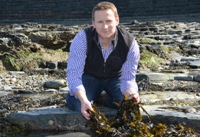Rhythm of life

Dr David Wilcockson studies organisms in the rock pools at Aberystwyth
10 April 2013
The secrets of how animals adapt to the ebb and flow of the tide are revealed by Aberystwyth University lecturer Dr David Wilcockson in ‘The Secret Life of Rock Pools’ a television documentary broadcast on BBC4 on 16 April 2013.
The programme’s presenter, Professor Richard Fortey embarks on a quest to discover the extraordinary lives of rock pool creatures. He is joined by Dr David Wilcockson, aquatic lecturer in IBERS, Aberystwyth University and other leading marine biologists to help explore this unusual environment.
Startling behaviour is revealed and new insights are given into how these animals cope with intertidal life at the National Marine Aquarium in Plymouth and on the beach in various locations around the UK.
Describing his contribution Dr Wilcockson explains “Animals that are challenged by regular, periodic inundation and exposure by the ebb and flow of tides coordinate their behaviour and physiology. This is what enables them to survive and flourish in a complex and rapidly changing place.”
One major theme of the research is the biological clocks deep in the brains of animals such as crustaceans.
Dr Wilcockson explains “All organisms, including humans possess biological clocks in their brains which keep time with the environment. They make them behave in certain ways at different times of the day. However, whereas humans and other land or terrestrial creatures have 24 hour clocks synchronized by day light and night time cycles, intertidal animals have clocks that run on a tidal or 12.4 hour period.”
In the documentary Dr Wilcockson demonstrates how a marine relative of the woodlouse (Eurydice pulchra) swims at 12.4 hourly intervals in synchrony with the time of expected high-water at its home-beach. This happens even if it is removed from its normal environment - in this case it was moved from Aberystwyth to Plymouth.
Research conducted at IBERS reveals how organisms of the intertidal must have timing mechanisms to enable them to swim, forage, mate and rest at the correct time of the tide. They can even anticipate tidal movements so that they can prepare themselves in advance for activity or rest.
Dr Wilcockson added more detail on the fascinating behaviour found on the sea shore. “In the programme I also demonstrate that female crabs release potent pheromones that attract males and stimulate them to express stereotyped behaviour. This behaviour has evolved to guard females as they get close to shedding their hard carapace in order to grow. It is then and only then that the males can copulate with the females.
This example illustrates how pheromones are used by some species to initiate courtship and reproductive behaviour in the aquatic realm. “
Dr Wilcockson’s research is funded by the BBSRC (in collaboration with Leicester and Bangor Universities and the Laboratory of Molecular Biology, Cambridge) and NERC.
‘The Secret Life of Rock Pools’ is broadcast on BBC4 at 9.00p.m on Tuesday 16 April 2013.
AU12913



